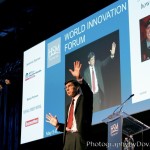Jun08
MinuteClinic’s Service Design Innovation
Point: Take the customer’s perspective when designing a new service model.
Story: Some of the best innovations are brilliant in their after-the-fact simplicity. Take MinuteClinic. We all know “an ounce of prevention…” yet most of us still don’t go to the doctor for preventative care because of the cumbersome process of a office visit: scheduling an appointment,  taking time off work, waiting in the doctor’s office for unknown amounts of time, sitting in the midst of other hacking/sneezing people, and being unsure how much the visit will cost. Worse, the doctor’s advice is often the standard nostrums of “take two aspirin, eat right, drink plenty of fluids, get some rest” that didn’t require the costs and hassles of the office visit.
taking time off work, waiting in the doctor’s office for unknown amounts of time, sitting in the midst of other hacking/sneezing people, and being unsure how much the visit will cost. Worse, the doctor’s advice is often the standard nostrums of “take two aspirin, eat right, drink plenty of fluids, get some rest” that didn’t require the costs and hassles of the office visit.
Michael Howe, former CEO of MinuteClinic, became known as one of the top 10 innovators of the last decade by tackling those problems and designing a straightforward solution. Howe applied the retail concept to healthcare, putting a mini medical clinic inside a pharmacy. All the elements of his new service model focused on the customer:
- Pharmacy locations are easy to get to and are easily integrated into the customer’s day
- The clinics are open nights and weekends, expanding convenience for time-pressed customers
- Customer wait time is no more than 15 minutes, and no appointments are necessary.
- MinuteClinic posts all its services on a “menu” with the prices listed for each service
The key behind Howe’s innovation is realizing that the old model of healthcare delivery focused on delivering healthcare to people born 1925-44. But the values of this “Greatest Generation” aren’t the same as the Boomer generation. Boomers don’t want to be directed — they want to be engaged in the healthcare process. Likewise, Gen-X’ers (born 1965-1984) want self-sufficiency, convenience and immediate access. They, along with Boomers, constitute MinuteClinic’s target customers.
MinuteClinic focuses on providing a standardized set of services that can be provided by nurse practitioners, thus lowering the overall costs of the services. The company doesn’t claim to compete with the expertise of Mayo Clinic. Rather, it focuses on minor illness exams, minor injury exams, skin condition exams, wellness & prevention, vaccinations, and health condition monitoring. If customers have a serious or unusual ailment, MinuteClinic will recommend that they seek more in-depth medical attention.
In 2006, CVS acquired MinuteClinic. I asked Howe if the acquisition meant there could be more data integration between the two merged companies. His answer was that although the regulatory statutes prevent the sharing of information like prescriptions without patient approval, it was possible to educate patients. “We can use the retail environment to inform patients of alternatives to use for preventative medicine,” Howe said. For example, during the cold and flu season, MinuteClinic could help patients by producing a list of suggested treatments to make it through flu season.
What will be the next healthcare delivery innovation? Using Howe’s model of generations and the different values which each generation has, Howe sees that Millennials (born 1985-2004) are just beginning to understand their needs and that they want technology-based connections. In that future, the mantra will move from the Boomers’ “Engage Me” to the Millennials’ “Connect Me” demand for technology-based connections to their cell phones, laptops and the digitized world of social networks.
Action:
- Look for products and services that have become costly and underutilized due to years of accumulated complexities
- Look for generational differences in expectations, tolerances, and preferences
- Create a solution that increases convenience and certainty
- Create a solution that reduces complexity and cost
- Address 80% of the problem with something simple rather than 100% of the problem with something complex
Sources:
Michael Howe spoke at the World Innovation Forum, held June 8-9, 2010 at the Nokia Theater in New York City. He also presented an online seminar in the HSMAmericas series, which can be accessed here.
See also http://minuteclinic.com/
Comments Off on MinuteClinic’s Service Design InnovationCase study, How-to, Innovation











